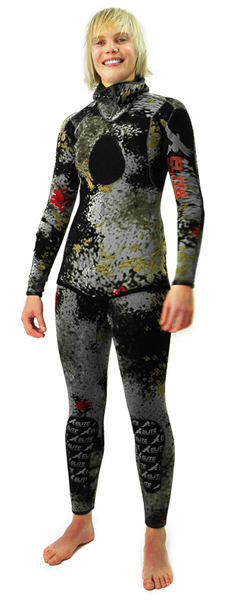Buying Your First Spearfishing Wetsuit
March 30, 2011 3 min read

When it comes to spearfishing, wetsuits vary in price, quality, comfort and suitability. There are a few important things to remember when purchasing your first spearfishing wetsuit so make sure you click through to read them.
Firstly, you must think about the areas you will be spearing in in terms of temperature. Most spearfishers here in SE Queensland invest in a 3mm wetsuit, however, this is often too hot in the warmer seasons and they will then remove the bottom half of their wetsuit. This leaves their legs exposed to cuts and spikes from reef or fish, and does not work well in terms of camouflage! While spearfishing, comfort is a huge factor. If you are cold you will not be able to get your heart rate down to dive, but if you are hot you will be losing substantial amounts of fluids through sweat which can lead to dehydration.
You need to choose a wetsuit to suit the diving conditions you will be exposed to. Anyone closer to the equator, for example, may only need a 1.5mm wetsuit all year round. But for someone in Australia, we would recommend purchasing two suits to start off with that will suit you in your area all year round. For example, a Queensland diver would suit a 1.5mm suit for the warmer months and a 3mm suit for the cooler months. Investing in that extra wet suit will ensure you are safe from the dangers that fish spikes and especially teeth can pose to a spearfisher.
For people who are serious about the sport, however, it is important for them to have up to three or four wetsuits. For a Brisbane diver, a 1.5mm, 3mm and 5mm wetsuit would allow you comfort during the warmer months as well as if you are planning on travelling anywhere down past the border. Have a talk to the spearfishers in your area to get an idea of the kind of wetsuit thickness they use before deciding which wetsuits you should purchase.
It is important for us freedivers to remember that excess neoprene is an enemy and we should only have enough to make us comfortable! This is because neoprene is an extremely buoyant fabric which means the more wetsuit thickness we have on, the more lead weights we need to get us down. However, as you descend past 15m the neoprene compresses and you are less buoyant. This means that going down will be harder with more buoyancy and coming up will be much harder with less buoyancy and more weights! Having the right thickness in wetsuit will make for a safer, more enjoyable dive.
Next, you need to consider the camouflage, if any, you would like on your wetsuit. Again, this needs to be decided according to the kind of diving you are doing. There is no point having blue camo gear if you are going to be spearing mostly in rocks and on reef. This is another reason why having more than one wetsuit is handy, not only for comfort, but for getting a wide range of fish species.
The final important component of a wetsuit is a hood. If your wet suit does not include a hood it is important to purchase one as it will protect you from many nasty jelly stings and also keep you warm as your body temperature often depends on the warmth of your ears or head!
Once you have your wetsuits it is important to keep them in top condition. We recommend purchasing a neoprene wetsuit wash which will keep your wetsuit from getting that dreadful smell after many ‘wetty warmers’ and the bacteria that can grow in constantly damp items, as well as keeping the neoprene strong which will reduce the risk of tearing!



